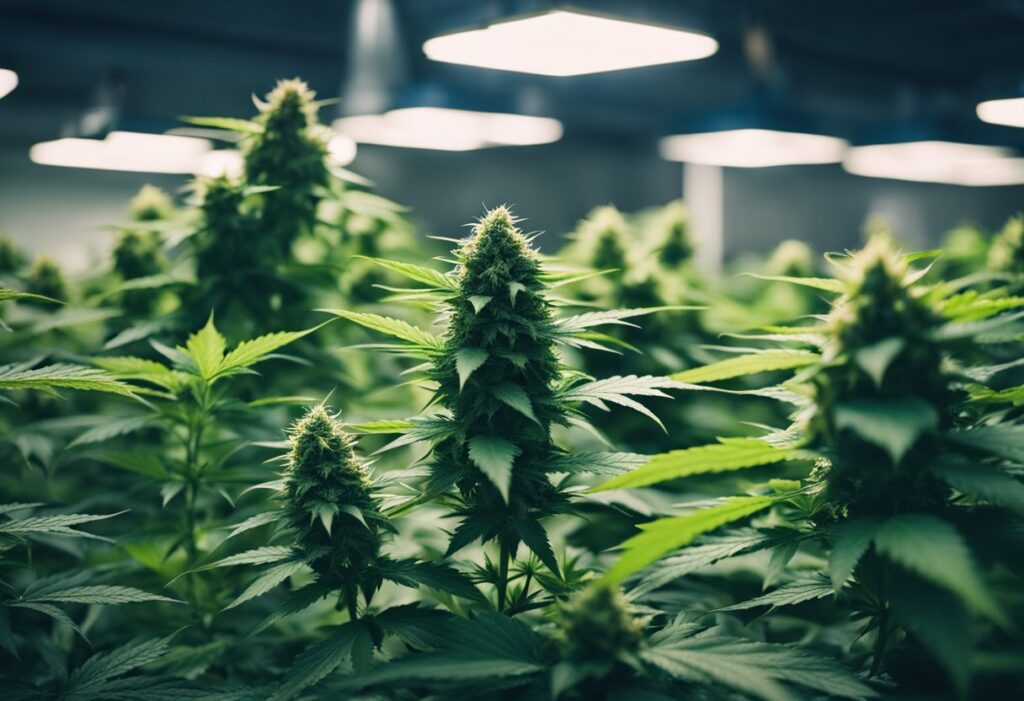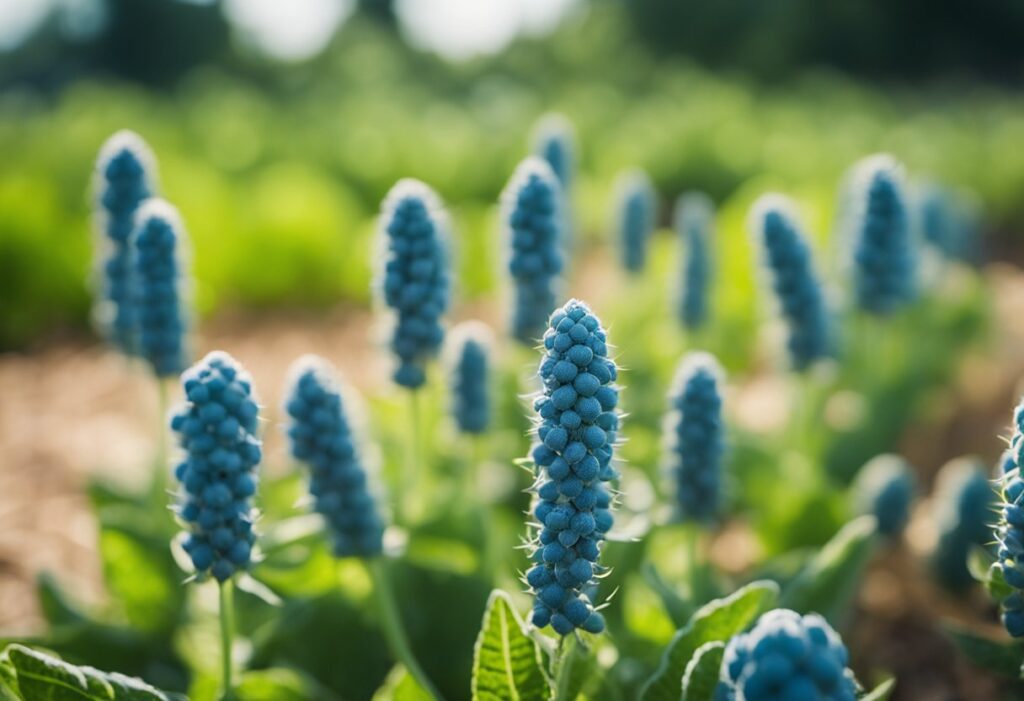
As a grower in the USA, recognizing the genetics and characteristics of Blue Dream seeds is pivotal to your success. Here’s an insight into the strain’s legendary origins and its famed sativa-dominant effects.
Blue Dream has become a legendary name in cannabis culture, revered for its balance of invigorating effects and easy cultivation. Your Blue Dream plants owe their genetics to two iconic parent strains: Haze and Blueberry. The Haze strain, a sativa, contributes to the cerebral and invigorating qualities of Blue Dream, while the indica-dominant Blueberry is responsible for the relaxing and happy sensation often associated with the use. The fusion of these strains has created a hybrid that captures the essence of both sativa and indica effects.
Blue Dream’s sativa-dominant nature predominantly evokes feelings of euphoria and happiness, making it a preferred strain for daytime use. The THC content in Blue Dream can vary, but it typically boasts a high level, contributing to its powerful effects. You will notice the influence of its sativa genetics through the energetic and uplifting experience it imparts.
Your sensory experience with Blue Dream extends to its *aroma and flavor profile. The strain commonly presents a sweet berry scent coupled with herbal and floral notes, attributable to the Blueberry and Haze lineage. The balanced aroma profile, which includes:
This complements its flavor, making Blue Dream a delight not just in effects but in taste and smell as well.

To successfully cultivate Blue Dream cannabis seeds, your preparation sets the foundation for a thriving crop. You’ll need to make informed decisions about seed selection, growing mediums, and the proper environmental conditions to optimize your plants’ health and yield.
When starting with Blue Dream seeds, you have the option between feminized seeds or clones. Feminized seeds are your best bet if you aim for a more straightforward cultivation process with guaranteed female plants, which are the ones that produce the buds. On the other hand, clones can offer a consistent replica of a parent plant, though they require a mother plant and are more susceptible to pests and diseases.
Your choice of growing medium profoundly impacts your Blue Dream’s growth. Soil is the traditional choice and is often praised for its buffer against pH and nutrient fluctuations, contributing to the overall terpene profile.
Hydroponic systems, conversely, provide greater nutrient control and can lead to faster growth and potentially higher yields. However, they require a more hands-on approach when it comes to maintaining the system.
Blue Dream seeds flourish in a stable and controlled environment. They thrive in warmer conditions with temperatures around 75-85°F (24-29°C). Consistency is key, so it’s crucial to maintain these optimal temperatures particularly during the flowering stage.
For humidity levels, start higher at 60-70% for germination and gradually decrease to 30-40% as you near the flowering phase. Outdoor growers should aim for a climate that can naturally provide these conditions, while indoor growers have the advantage of adjusting levels to perfection.
By choosing the right Blue Dream seeds from a reputable source like Farmers Lab Seeds, selecting a fitting growing medium, and maintaining the right climate and temperature, you’re poised to cultivate a robust and productive cannabis garden.

Growing Blue Dream seeds successfully involves a detailed approach from the very start. Your vigilance and care through each phase, from germination to harvest, are crucial in cultivating a healthy and abundant crop.
To begin, place your Blue Dream seeds in a controlled environment with a balance of warmth and humidity—aiming for around 75-80°F and 60-70% humidity levels. A gentle airflow is beneficial. During the early vegetative phase, your seedlings require indirect light, progressively moving to a more intense lighting as they grow stronger.
Training your plants by gently bending and tying down branches can increase sunlight exposure and air circulation, leading to higher yields. When your plants have developed several nodes, topping — cutting off the top part of the main stem — encourages bushier growth. Remember to prune carefully, removing only dead or overgrown foliage to maintain plant health and promote better yields.
As your plants enter the flowering stage, switch the light cycle to 12 hours of light and 12 hours of darkness. This mimics autumn’s conditions and triggers blooming. Nutrient needs shift during this phase; focused applications of phosphorus and potassium support the development of robust buds. Monitor humidity levels, ideally keeping them between 30-40% to prevent mold and mildew.
Harvest time is determined by examining the color of the trichomes on the buds. When most trichomes are milky white with some amber, it’s time to harvest. Don’t rush—harvesting at the right moment ensures maximum potency and flavor. Using clean tools, cut down your plants, and prepare for drying and curing.

Growing Blue Dream, one of the most revered marijuana strains for its balanced effects, requires diligence, especially in managing pests and diseases. Here, you’ll learn targeted strategies to keep your crops thriving.
You play a crucial role in preventing infestations and diseases by creating an unwelcoming environment for pests and pathogens. Begin by regulating the humidity levels in your growing area to between 60-70%, as excessive moisture can invite mold. Employ natural predators, like ladybirds, to control aphids. For ant management, diatomaceous earth can be an effective deterrent when sprinkled around plant bases.
Your Blue Dream plants could be threatened by pests such as ants, spider mites, and aphids. If you spot any, it’s essential to act promptly. A targeted insecticide can address these invaders effectively while preserving your plants’ health. When applying treatments, ensure you follow the instructions carefully to avoid harming your plants.
Lastly, mold and fungi can be particularly devastating. If you notice any discoloration or fuzzy growth, it may indicate the presence of mold. In such cases, reducing the area’s humidity and employing a suitable fungicide can help control the outbreak. Ensure proper air circulation around your plants to prevent future occurrences.

After harvesting your Blue Dream seeds from Farmers Lab Seeds, it’s essential to focus on drying, curing, and storing. Proper techniques ensure maximum flavor, aroma, and potency retention.
To begin drying, carefully hang your cut Blue Dream plants upside down in a controlled environment. Aim to maintain a temperature range of 60-70°F (15-21°C) and humidity levels between 45-55% to facilitate a slow and even drying process. This will help preserve the THC content and terpenes responsible for potency and aroma.
Remember to ensure proper airflow around the buds to prevent mold and to check them daily for even drying.
Once dried, your buds require curing to further enhance their flavor and efficacy. Place the buds into airtight containers, opening them once a day for the first week to let them “breathe,” a process known as burping. This will help regulate humidity and allow gases to escape. Aim for an ideal relative humidity of 50-60% within the containers. The correct curing process can significantly boost the overall quality of your Blue Dream strain.
This step is crucial for breaking down chlorophyll and concentrating the terpenes and cannabinoids.
For long-term storage, transfer your cured buds to dark, airtight containers and store them in a cool, dry place. By protecting your cannabis from light and fluctuations in temperature and humidity, you preserve its quality over time. Your buds can maintain their potency and aroma for up to 12 months if stored correctly.
Each of these steps, from drying to storing, plays a pivotal role in safeguarding the sensory and chemical integrity of your Blue Dream cannabis.
In this section, you’ll find specific advice and tips on maximizing the potential of your Blue Dream cannabis plants, one of the most sought-after strains in the USA.
For outdoor growth, Blue Dream seeds thrive in mild to warm climates with plenty of sunshine. They flourish in temperatures between 70-85°F, but can tolerate slight variations. Ensure they’re planted in an area that receives full sun for most of the day.
Blue Dream typically requires a flowering period of 8-10 weeks. This can vary slightly based on environmental factors and whether you’re growing indoors or outdoors.
To increase your Blue Dream yield, consider techniques such as topping or fimming to encourage bushier growth. Using sea of green (SOG) or screen of green (SCROG) methods can also help maximize light exposure and air flow, leading to more bountiful harvests.
Common pests that challenge Blue Dream plants include spider mites, aphids, and caterpillars. Combat these by maintaining good air circulation, keeping the grow area clean, and using organic pesticides if necessary. Monitoring your plants regularly helps catch infestations early.
Blue Dream is often ready for harvest around the end of the flowering phase, typically around the 9th or 10th week. Watch for the trichomes on the buds to turn a milky white color, indicating peak THC levels and readiness for harvest.


WE ARE EVERY GROWERS ONE STOP SHOP TO ACQUIRE PREMIUM CANNABIS SEEDS FOR SALE IN THE USA, CANADA AND AUSTRALIA
Farmers Lab Seeds 2024,
All Right Reserved
Seeds are sold as novelty items, souvenirs, and collectibles. They contain 0% THC. We encourage our customers to check the legislation in their Country, State, Province, and Municipality prior to purchasing items from our store. We do not provide growing information.
All seeds are sold as hemp, and lab tested under 0.3% THC. This product is not for use by or sale to persons under the age of 21. This product should be used only as directed on the label. It should not be used if you are pregnant or nursing. Consult with a physician before use if you have a serious medical condition or use prescription medications. A Doctor’s advice should be sought before using this and any supplemental dietary product. All trademarks and copyrights are property of their respective owners and are not affiliated with nor do they endorse this product.
These statements have not been evaluated by the FDA. This product is not intended to diagnose, treat, cure or prevent any disease. Individual weight loss results will vary. By using this site, you agree to follow the Privacy Policy and all Terms & Conditions printed on this site. Void Where Prohibited by Law.